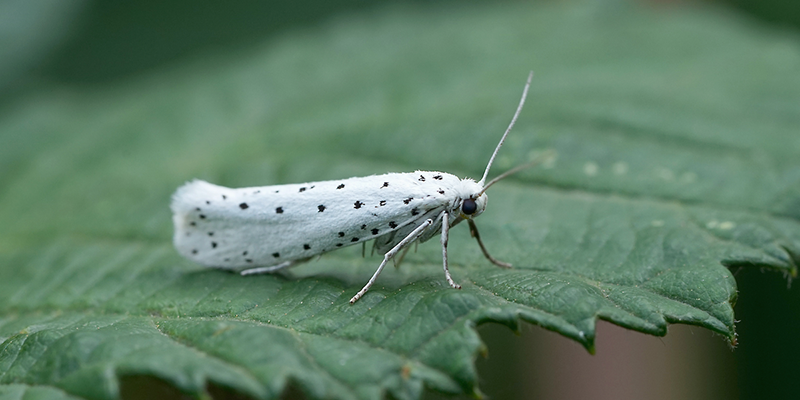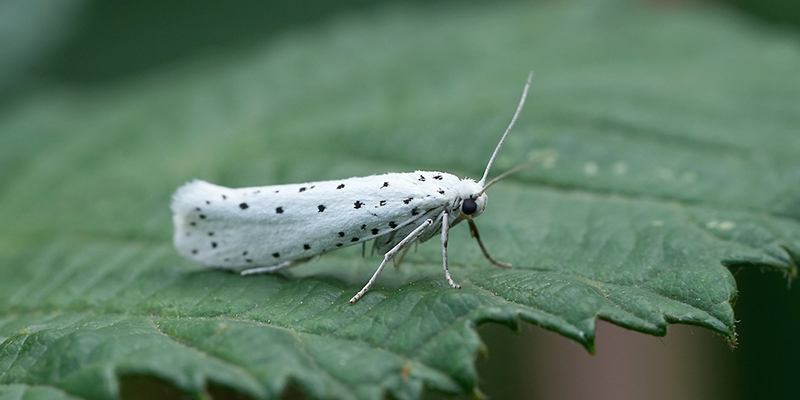How a Moth’s Wings Create Ultrasonic Clicks
In engineering, the buckling of a structure, such as a bridge, often preempts its catastrophic failure. In nature, however, buckling can be a positive feature, providing a structure with new capabilities. For example, the buckling of ridge-like structures on the wings of an ermine moth can generate bursts of ultrasonic clicks that can deter predators. Now scientists from the University of Bristol, UK, have explained how this mechanism works [1]. This finding provides insights for bio-inspired designs of soft robots, acoustics-based monitoring devices for the structural health of buildings, and objects that can morph from one shape into another.
Moths have long been known to possess sound-based mechanisms to deter predators that use echolocation to detect prey. For example, a tiger moth can snap sound-producing organs (tymbals) located in its thorax to create ultrasonic clicks that deter bats. Ermine moths, of which there are several hundred species, produce defensive sounds in a different way.
The tymbals of an ermine moth are in its wings. These structures produce two bursts of ultrasonic clicks in each wingbeat cycle—one during the upstroke and one during the downstroke. The clicks have the right frequency to confuse the echolocation abilities of a nearby bat, making the bat think the moth is unpalatable. The clicks thus provide an ermine moth with a passive acoustic defense system that becomes active whenever it is in flight. “These insects don’t have ears, so they don’t know that they’re producing this sound,” says Marc Holderied, one of the researchers on the study. “Evolution has equipped them with this fantastic tool in their wings that protects them against bats, and they don’t even know about it.”
Like all moths, the ermine moth has four wings—two forewings (top) and two hindwings (bottom). Along the lower portion of the hindwing lies a fold line called the claval fold, which runs from near the insect’s anus to the hindwing’s lower edge. Along the claval fold runs a line of striated structures—the tymbals. These structures have been linked to the insect’s clicks, but until now how they were involved in making the sounds remained unknown.
To determine exactly what makes these tymbals click, Holderied and his colleagues monitored the wing flapping of various species of ermine moth. They used a stereo microscope and an x-ray tomograph to capture the two- and three-dimensional behavior of the tymbals as the wings moved and a laser scanning confocal microscope to probe the material properties of different parts of the moths’ wings. The researchers also conducted computer simulations of the tymbals during flight.
The experiments and simulations indicate that curvature changes in the hindwings during the wingbeat cycle caused the tymbals to buckle sequentially. This buckling excites vibrations in a neighboring region of the wing that is free of scales and feathers. This excitation then amplifies the vibrations, which have ultrasonic frequencies, radiating them into the environment. Holderied likens the process to that which occurs during a rim shot—a percussive drumming technique that involves simultaneously hitting the rim and the head of a drum. He says that the sequential clicks are essentially a series of rim shots, which use the drumhead to amplify the sounds of the rim being hit, allowing them to be heard farther away.
Jagmeet Kanwal, an expert in the auditory processing of bats at Georgetown University, Washington, DC, says that the findings by Holderied and his colleagues provide a clear explanation of the acoustic defenses of ermine moths. He thinks the findings could impact developments in biomimetic engineering, which he believes is where the future of engineering lies.
–Payal Dhar
Payal Dhar is a freelance science writer based in Bengaluru, India.
References
- H. M. Nava et al., “Buckling-induced sound production in the aeroelastic tymbals of Yponomeuta,” Proc. Natl. Acad. Sci. U. S. A. 121 (2024).





